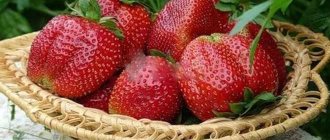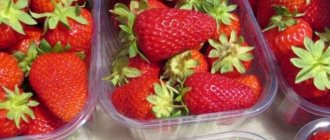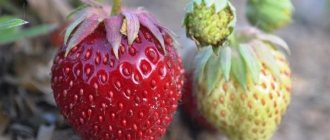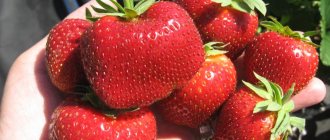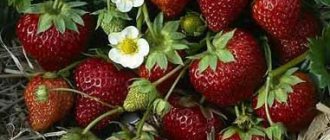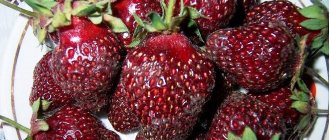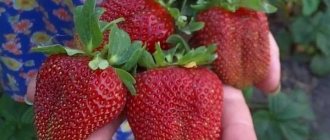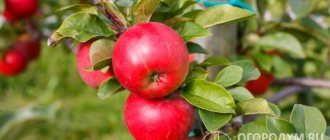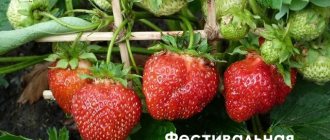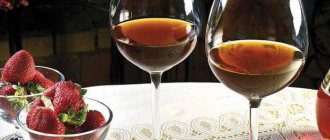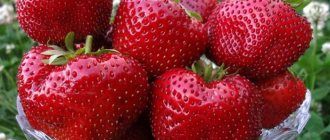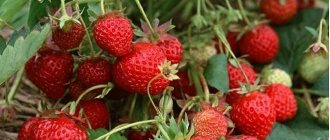Bereginya is a non-repairing variety of domestically produced garden strawberries. The variety was bred by scientists from the Kokinsky stronghold of the All-Russian Selection and Technological Institute of Horticulture and Nursery Growing. To obtain this variety, the following varieties were used:
- Gonzago.
- American Concorde.
Since 2007, domestic garden strawberries Bereginya began to undergo state tests. In 2012, the variety was accepted into the State Register of the Russian Federation.
This variety is recommended to be grown in the Central region of our country.
In today's publication you can find a description of the variety, photos of Beregini berries and reviews of gardeners who managed to grow a domestic beauty on their plot.
Characteristics of the Bereginya variety
Beregini's bush is medium-sized, semi-spreading, heavily covered with leaves. The leaf blades are medium in size, slightly wrinkled. The color of the leaves is light green. The leaves are glossy.
The flowers of Bereginya garden strawberries are bisexual, which indicates self-fertility. That is, additional pollinators are not needed for this variety.
The inflorescences are compact, consisting of a large number of medium-sized white flowers.
Peduncles are quite strong, located at the level of the leaves.
The bush produces a moderate amount of tendrils. Mustache of medium length, pale red color.
Beregini's fruits are medium-sized and blunt-conical in shape. The berry does not have a neck. The shell is orange-red, glossy. The pulp is red in color, dense in structure, very juicy. The berry exudes a pleasant strawberry aroma.
Despite the high density of the berries, they still have small voids inside.
The achenes are yellow in color and located superficially.
The berries have dessert taste. Beregini fruits are very sweet. At the same time, there is a slight note of sourness, which only complements the flavor palette. Tasting rating of Beregini berries - 4.5 points out of 5.
Composition of substances per 100 g of product:
- Sakharov - 5.7 g.
- Acids - 0.8 g.
- Vitamin C - 79 mg.
Due to their high density, berries are very easy to transport over long distances. Also, this contributes to the long-term preservation of the crop after harvesting.
This variety is universal. Beregini berries are suitable for fresh consumption and for processing into jams, preserves, compote. Also, the fruits of these garden strawberries can be frozen.
The variety is quite late in maturity. The ripening of berries begins approximately in the second decade of June. Fruiting is uniform throughout the entire growing season. The berries do not become smaller by the end of the season.
Beregini's berries are quite small, on average about 15 g. There are also specimens weighing 30 g.
Productivity is also not the highest. From 1 hectare you can harvest 150 centners of garden strawberries. On average, about 350 g of strawberries are harvested from 1 bush, which is very little compared to many Dutch varieties, which produce about a kilogram of berries from 1 plant.
Positive and negative qualities of this variety
Domestic garden strawberries have a lot of advantages, which is why they are actively cultivated on gardeners’ plots. Among the main advantages of Beregini it is worth highlighting:
- The variety is bisexual, which makes it self-pollinating. Bereginya does not need to plant an additional pollinator plant.
- The berries do not become smaller by the end of the season.
- The bushes form a sufficient number of tendrils, which allows strawberries to be propagated in this particular way.
- Bereginya is unpretentious to weather conditions and can grow in any region of our country.
- She has a fairly strong immune system that protects her from a number of diseases.
- The berries have high commercial quality. The berries are beautiful, sweet, and easily transported over long distances.
At the same time, we should not forget about the disadvantages of this variety. In general, there are not so many of them:
- Despite its strong immunity, the variety is quite susceptible to diseases such as gray rot. It is worth immediately noting that this disease develops in conditions of high humidity, so if you properly care for the crop, the risk of gray rot will be minimal.
- The berries may seem small, especially to those gardeners who have grown Dutch varieties of garden strawberries.
A few more secrets of professionals
A number of secrets will allow you to avoid additional contamination of strawberries by a number of pests that manage to settle in Beregin even after pre-treatment of strawberries:
- During the process of planting the variety, as additional care, gardeners recommend carrying out additional soil cultivation measures.
- The more often shrubs are transplanted to another area, the better. But you shouldn’t get carried away either.
- To prevent the spread of earthen pests on the plantations, the berries should be treated from weeds in a timely manner.
- The best place to plant the Bereginya variety is considered to be the area where plants grow that repel garden pests. For example, gardeners include lupine flowers among such plants.
Knowing these secrets, you can significantly simplify the process of caring for berries and not be afraid of additional infection with unwanted bacteria.
Correct fit
Before starting planting work, it is necessary to select and prepare a site. Choose a sunny place, without neighboring trees or tall crops (sunflowers, corn, etc.). The area must be clean, free of weeds.
6 months before planting strawberry seedlings, the garden is fertilized. Humus is used at the rate of 8 kg per 1 m2.
It is also desirable that the site be protected from northern winds, but at the same time have good natural aeration.
The planting scheme itself looks like this:
- The first step is to dig out the planting hole. Its diameter is about 30 cm, and its depth depends on the length of the root system, but on average 15-30 cm.
- The holes are dug at a distance of 25-30 cm from each other. The distance between the holes is maintained at around 60-70 cm. This distance will allow you to easily care for the crop and harvest the crop without any problems.
- After the holes are dug, they are watered generously with water. About 1000 ml of water is consumed per hole.
- When the water in the holes is absorbed, seedlings are placed in them. The seedlings must be placed strictly vertically in the hole, while carefully straightening the root system.
- After the seedling is placed in the hole, it is sprinkled with soil and compacted. At the end of planting, the plants are watered again. The consumption is the same, about 1 liter of water per 1 bush.
Features of cultivation
Photo of planting strawberries Bereginya
Planting Bereginya strawberries is exactly the same as in the case of any other strawberry. First you need to choose a planting method (on agrofibre, in ridges, in trenches, etc.), then the ground is fertilized, and holes are prepared for planting. The pits should be located at a distance of 30-45 cm from each other. 50-70 cm are left between the rows. After this, it is necessary to select high-quality planting material and plant. Each bush is carefully placed in a hole moistened with water and sprinkled with earth.
Maintenance is not difficult, the main thing is to water it on time - the soil should not dry out. Weeds are removed as they appear. It is advisable to immediately pull them out by the roots - this will make subsequent cleaning easier - the fewer roots of weeds in the ground, the fewer weeds themselves. Weeding is needed constantly. It is done after watering, when the water is absorbed, so that the soil does not crust over. For the winter, you can mulch the ground 15-20 cm with straw; agrofibre is also suitable.
Interesting! Interesting! Treatment for diseases of Bereginya strawberries is rarely required, but for pests a couple of times a season will not hurt. If such problems are not uncommon on the site, it is worth carrying out preventive spraying with folk substances 3-4 times during the growing season.
Fertilizers are applied according to the standard:
Feeding and care photo
- The first is needed for the growth of the root system and foliage. In this case, nitrogen substances are needed.
- During flowering, potassium, calcium, manganese, phosphorus, iron, boron and many other substances - complex fertilizers - will not interfere with the bushes. But the amount of nitrogen needed is minimal. Such fertilizers help increase productivity and improve the immune system.
- At the end of the season, when the bushes have faded and the entire strawberry crop has been harvested, it is possible, and even necessary, to feed the plants with calcium and phosphorus to restore the strength of the strawberries.
Rules of care
Despite the fact that garden strawberries seem to be a complex crop, caring for them is quite simple. The basis of care is timely watering and fertilizing of the plant. Also, if the variety has a tendency to develop strong whiskers, the whiskers will need to be removed.
We also recommend reading: Description of the Eliane strawberry variety
Feeding
Fertilize strawberries 3 times per season:
- In the first year after planting seedlings, the crop does not need fertilizers. Starting from the second year of life, the plant begins to be actively fed. The first feeding is carried out immediately after the end of the cold weather, in early spring. At this time, it is advisable to feed garden strawberries with nitroammophos (the solution is prepared as follows: dilute 1 tablespoon of the substance in a bucket of water).
- During the formation of ovaries, the plant needs phosphorus-potassium fertilizers.
- In the fall, after harvesting, strawberries are fed with organic matter. The plant needs it in order to saturate it with nutrients and prepare it for winter sleep.
Watering
Lack of moisture can lead to a deterioration of the plant's immune system or its complete death. Therefore, you should always water your garden strawberries. But at the same time, we should not forget that the variety is highly susceptible to gray rot, which, by the way, develops in conditions of high humidity, so water the strawberries moderately, without creating a wetland around.
Usually water Bereginya once a week. Such watering is quite enough to ensure maximum crop productivity.
During dry periods, the number of waterings is increased to 2 per week, sometimes up to 3.
If a drip irrigation system is not used, then it is advisable to water the strawberries in the morning and evening, when the sun is in an inactive phase and cannot burn the leaves.
Water the garden strawberries with settled warm water. You cannot water from a well, as cold water can lead to the development of various diseases.
Video
A gardener from the Bryansk region shares his experience of growing several varieties of strawberries from the Kokinsky selection in the following video:
You can evaluate the productivity of Bereginya strawberries from a video filmed in the Belgorod region:
For several years she worked as a television program editor with leading producers of ornamental plants in Ukraine. At the dacha, of all types of agricultural work, she prefers harvesting, but for this she is ready to regularly weed, pull, shed, water, tie, thin out, etc. I am convinced that the most delicious vegetables and fruits are those grown with your own hands!
Found a mistake? Select the text with the mouse and click:
Humus is rotted manure or bird droppings. It is prepared like this: the manure is piled up in a heap or pile, layered with sawdust, peat and garden soil. The pile is covered with film to stabilize temperature and humidity (this is necessary to increase the activity of microorganisms). The fertilizer “ripens” within 2-5 years, depending on external conditions and the composition of the feedstock. The output is a loose, homogeneous mass with a pleasant smell of fresh earth.
It is believed that some vegetables and fruits (cucumbers, stem celery, all varieties of cabbage, peppers, apples) have “negative calorie content,” that is, more calories are consumed during digestion than they contain. In fact, only 10-20% of the calories received from food are consumed in the digestive process.
Oklahoma farmer Carl Burns developed an unusual variety of multi-colored corn called Rainbow Corn. The grains on each cob are of different colors and shades: brown, pink, purple, blue, green, etc. This result was achieved through many years of selecting the most colored ordinary varieties and crossing them.
You need to collect medicinal flowers and inflorescences at the very beginning of the flowering period, when the content of nutrients in them is highest. Flowers are supposed to be picked by hand, tearing off the rough stalks. Dry the collected flowers and herbs, scattered in a thin layer, in a cool room at natural temperature without access to direct sunlight.
Compost is rotted organic remains of various origins. How to do it? They put everything in a heap, hole or large box: kitchen scraps, tops of garden crops, weeds cut before flowering, thin twigs. All this is layered with phosphate rock, sometimes straw, earth or peat. (Some summer residents add special composting accelerators.) Cover with film. During the process of overheating, the pile is periodically turned or pierced to bring in fresh air. Typically, compost “ripens” for 2 years, but with modern additives it can be ready in one summer season.
In little Denmark, any piece of land is a very expensive pleasure. Therefore, local gardeners have adapted to growing fresh vegetables in buckets, large bags, and foam boxes filled with a special earthen mixture. Such agrotechnical methods make it possible to obtain a harvest even at home.
Both humus and compost are rightfully the basis of organic farming. Their presence in the soil significantly increases the yield and improves the taste of vegetables and fruits. They are very similar in properties and appearance, but they should not be confused. Humus is rotted manure or bird droppings. Compost is rotted organic remains of various origins (spoiled food from the kitchen, tops, weeds, thin twigs). Humus is considered a higher quality fertilizer; compost is more accessible.
“Frost-resistant” varieties of garden strawberries (more often simply “strawberries”) need shelter just as much as ordinary varieties (especially in those regions where there are snowless winters or frosts alternating with thaws). All strawberries have superficial roots. This means that without shelter they freeze to death. Sellers’ assurances that strawberries are “frost-resistant,” “winter-hardy,” “tolerates frosts down to −35 ℃,” etc. are deception. Gardeners must remember that no one has yet managed to change the root system of strawberries.
A new product from American developers is the Tertill robot, which weeds weeds in the garden. The device was invented under the leadership of John Downes (creator of the robot vacuum cleaner) and works autonomously in all weather conditions, moving over uneven surfaces on wheels. At the same time, it cuts off all plants below 3 cm with the built-in trimmer.
Pests and diseases
The variety feels great in various climatic growing conditions. It has fairly high frost resistance and is resistant to heat.
According to many experts, Bereginya has higher immunity levels than most varieties of garden strawberries (tests were carried out in 2006-2008). The variety is resistant to diseases such as verticillium. Also, it is rarely affected by various fungal diseases. As for parasites, Bereginya is very rarely infested by a common insect - the spider mite.
In this case, you need to take into account the fact that garden strawberries show good immunity only in good growing conditions, so you need to provide them with proper care.
Reviews from gardeners
Valentina Yurievna, Kyiv, 52 years old.
I liked the Bereginya variety. Garden strawberries of this variety have a wide cone-shaped shape, slightly flattened. The pulp is tender, without fibers. The berries are large. The leaves have never been sick, although I have been growing Bereginya for the 5th year now. Among the shortcomings I would note poor resistance to moisture. When it rains, the berries rot, not all of them, of course, but some do.
Victor Dmitrievich, Ryazan, 42 years old.
I grew Bereginya in 2012, it showed itself as an ordinary variety of garden strawberry, approximately at the same level as Tsarina. The first berries weighed about 35 g, then they became very small, although I found in the description that they should not be small. The yield is high, despite the small size of the berries. Immunity is also good; in the two seasons that I cultivated it, I didn’t get any sores. But still, if compared with the Tsarina, then the Tsarina will be better, in my opinion.
